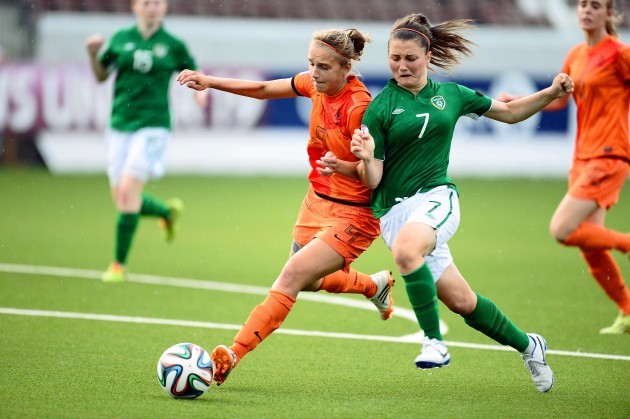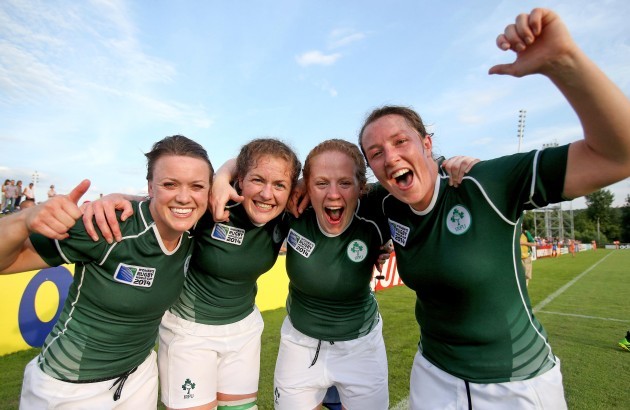ON 11 AUGUST 2014, Malachy Clerkin, a respected, opinion-forming journalist, wrote an Irish Times article entitled “If women’s sport struggles for coverage it’s not because of sexism – it’s because you can’t make people care”, and it irked me.
It irked me because it was a well-written, well-informed and perfectly captured the complication of writing about this topic, but I can’t agree with the conclusions.
At the time of reading the piece, I was 19,000 words into a Masters dissertation on how public relations could make people care about women’s sport in this country, and I believe in the practical potential of solutions to my findings.
Public relations agencies help governing bodies and organisations to manage their communications, reputation and commercial sponsorships. On the day to day, PR officers are the reason you hear about sporting successes, and there have been a few of great note in women’s sport this year.
Fiona Coghlan led the Irish women’s rugby team to the semi-finals of the Rugby World Cup; Stephanie Roche’s goal is nominated for the Fifa Puskas Goal of the Year Award; Briege Corkery has won 14 All-Ireland titles between Cork Camogie and Ladies Football; and Katie Taylor has won her record-equalling fifth consecutive World Championship title, making her arguably the greatest athlete this country has ever produced. And there are many more.
Much of the time, however, women’s sport and female athletes get far less than they deserve and their support and commercial potential doesn’t reach that of their male counterparts.
Stephanie Roche’s goal is in the running for the Fifa Puskas Award.
Sport for All
In January of this year, Irish Olympian Derval O’Rourke wrote an article on women’s sport for the Irish Examiner in which she referred to it as a ‘secret club’, with hundreds of thousands of people who are involved in hundreds of teams with thousands of athletes that nobody ever hears about.
Girls have gone from being restricted to the likes of netball and tennis to having the opportunity to play any sport they wish, and this is something everyone benefits from. Some significant problems, however, remain and they are largely centred on the idea of ‘appropriate’ and ‘in-appropriate’ sports for girls, and the manner in which this breaks down.
There are no manly or girly sports. Boxing and rugby present the same injury worries to fathers and mothers of boys as they do the girls and yes, girls can handle it. Public relations campaigns have the power to change and force thought on all sorts of misconceptions, and the Always #LikeAGirl campaign perfectly captures public relations’ potential in this regard.
The Also-Rans
Advocates for women’s sport will tell you that the goal for coverage of women’s sport is set at the unrealistically high standard of equality – 50-50. Well, my number is 3.3%.
This is the amount of sports coverage afforded to women’s sports during a sample that included the Ireland Women U19’s unprecedented run to the European Championship semis.
3.3% on average across the leading national print titles and inclusive of the national broadcaster’s primetime news.
3.3%.
The papers ranged from eight to 22 pages of sports coverage per day, so when asked if something else can give then the answer must be yes, it has to.
The trend is that women’s sport is ignorable until something great enough happens that it becomes novel. PR professionals working in women’s sport need to build media relationships and start the gentle expansion into an everyday feature. It is only then we will actually see if readers want to know about these sports or not.
The Formula
Success + Media Exposure = Increased Fan Support + Increased Commercial Attractiveness
Unfair? Maybe. Simple? Yes.
If you can’t give the media an Olympic gold medal winner then give them 5,000 people at a Ladies Gaelic Football or Irish women’s rugby game, and give it to them for every game. The research and rolling waves of Twitter debate both prove that advocacy for women can often draw exceptional levels of keyboard support, but it’s a lot harder to get people out to watch games.
Public relations can also help in this regard, and well-written match previews, build-up and engagement with fans at games should all be part of any match-day.
Maybe a radical approach is needed. Women’s games scheduled before men’s games would be great; free entry for people to see for themselves would be bold. Both would help significantly, and it only takes one sport to do it first.
The rest is a careful back and forth. It’s chicken and egg. Fans, commercial investment and sponsorship, media coverage — which comes first? Which is more important? From a public relations perspective these can only be answered on a case by case basis.
Small Steps
There is a worrying trend in coverage of women’s sports in that almost one-third of what does appear is in the ‘In Briefs’ in print, or without accompanying footage on television. Like all great athletes are told, ‘control the controllables and don’t worry about anything else.’ The same applies to women’s sport.
Social media allows women’s sports organisations and female athletes to define their sport and themselves, and gives them complete control over what information supporters and potential fans can or cannot have access to. It’s also the platform for great personal insights, as the behind the scenes nuggets and insights are exactly what all sports fans are looking for.
So, rule number one: Sports need to go digital and go direct to their target demographic. Who knows, your content might even have your athlete nominated for a global goal of the year competition.
Rule number two: Sponsorship. Sports sponsorship is the alignment of corporate partners and sports teams or organisations so that both can benefit from the sponsorship, and women’s sports are largely an easy choice.
Sponsors have the opportunity for prominence in a commercially un-saturated market where little investment goes a long way; direct access to a largely female demographic; and strong sentiment among a group of loyal followers and supporters.
AIG has achieved much with the inclusion of ladies football in their Dublin GAA deal, and so to has Liberty Insurance have in their addition of Camogie in their sponsorship of the Hurling championship.
It is the combination of these small things and the guiding hand of public relations that is providing sure footing on the first few steps of women’s sport’s long road to equality.
Colm Woods is an Account Executive at PSG Sponsorship, specialists in Sports PR and Sponsorship agency. His postgraduate research into PR’s ability to change the perception of women’s sport in Ireland earned a first class honours grade, and contributed to his achievement of the PRII Award for best overall PR student 2014.



